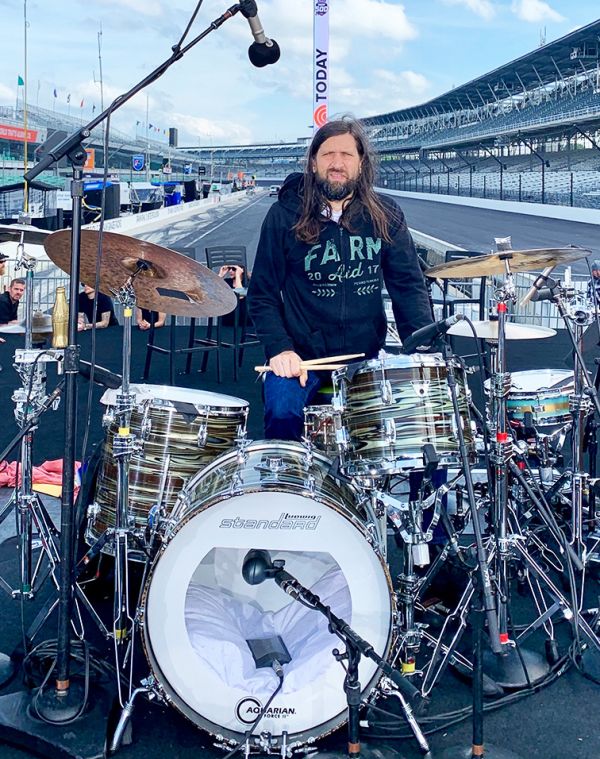

Cymbal Sound
With this classification system we establish common concepts and a language to describe cymbals.
The Classification System forms the basis for the sound descriptions given on the individual model pages. It helps you conceptualize how various parameters influence cymbal sound and function. You can use the conceptual framework for your deliberation process in determining your cymbals needs.
In designing and analyzing cymbals, we have determined that the various parameters of cymbal sound can be grouped into three logical groups:
- Physical Parameters – these can be measured physically and include: the SIZE and THICKNESS, which should be considered together as the WEIGHT (thickness proportional to the size of the cymbal); and the VOLUME (range where the cymbal performs well)
- Sound Character – these are the frequencies and harmonics produced by a cymbal which result in a very personal sound feeling and experience; they include COLOR (overall dominance of higher or lower frequencies), the RANGE (presence of lowest to highest audible frequencies) and the MIX (density of audible frequencies)
- Function – this area addresses how the cymbal reacts to what you do to it with a drum stick; it includes the ATTACK or stick sound (the immediate sound initially heard when striking the cymbal), the RESPONSE INTENSITY (the potency of frequencies developing from the vibration of the cymbal as a result of the stroke), the SUSTAIN (the audible length of the sound vibration), and type specific functional characteristics, such as the BELL CHARACTER in Rides, and the CHICK SOUND, the interaction of the two cymbals in a Hi-Hat; finally there is the FEEL of the cymbal (the feeling you experience in your hands and with the stick as you hit the cymbal or play rhythmic figures on it)
Classification System
Expand the sections below for a detailed discussion of the parameters.
-
Physical Parameters
Size and Thickness: Small to Large and Thin to Thick
These are the most basic characteristics. They determine the overall pitch and sustain of the cymbal. In simple terms, the larger a cymbal of a certain type gets, the lower its pitch will be and the thicker a cymbal of a certain size gets the higher its pitch will be. Also, the larger and/or thicker cymbals get, the longer the sustain will be. However, these characteristics do not exist by themselves, but will always be relative to each other, so they can only be used as a general starting point in thinking about cymbal sound.
Weight – Range: Extra Thin to Extra Heavy
This is defined as thickness proportional to size. It is important to understand that weight is a very relative concept, as it results from the combination of thickness and size. In general terms, as a cymbal gets thicker, the volume will be louder, the sound color will be brighter, the frequency range will be narrower, the mix more complex, the attack sound will become more pronounced, the response livelier, and the sustain longer. As a cymbal gets larger, the volume will be louder, the sound color will be darker, the range will be wider, the mix more complex, the attack or stick sound may go either way, the response will be livelier, and the sustain will be longer. The various combinations of weight and size may now balance out, reinforce, or negate these various tendencies. A good way to understand this interaction is to consider two extreme, diametrically opposite models. A very thick, very small cymbal will have medium volume, a very bright color, a narrow range, a clean mix, a very pronounced attack, a dry response, but a long sustain (because more mass almost always overrides size). A very thin, very large cymbal, will have medium volume, a very dark color, a wider range, a complex mix, a very washy attack, the response will be less lively, and the sustain will be long.
Volume – Range: Very Soft to Very Loud
This refers to the useful volume range of the cymbal. On the low end of the spectrum, we consider how softly we can play the cymbal before its character falls apart. This is best illustrated considering a big, thick, powerful Ride cymbal where at some point of softer playing not enough force is applied to properly excite the mass of the cymbal so it cannot unfold its full character. On the high end of the spectrum, we consider how strongly we can play the cymbal without overplaying it. Consider a medium size thin cymbal that will be played heavily in a loud setting. At some point of heavy hitting, not only will the cymbal lose its intended definition, but you also run the risk of destroying an otherwise perfectly well made and sturdy cymbal.
-
Sound Character
Sound Color – Range: Very Bright to Very Dark
This refers to the overall relative strength of higher to lower frequencies. It is important to understand that in almost all cymbals, the whole range of very low to extremely high frequencies is more or less present. It is the intensity of portions of the spectrum that give the cymbal its overall feeling of sound color. Generally speaking, higher frequencies are experienced as brighter, lower frequencies as darker. Consider also that the frequency range will subjectively alter the overall color feeling. The narrower the range, the more pronounced the sound color will be.
Frequency Range – Range: Very Narrow to Very Wide
Here we are considering the upper and lower frequency limits of all the frequencies present. In general, cymbals consist of roughly three layers of sound. On the lower end (“undertones”) we have the overall “gong sound” or basic pitch of the cymbal, which could be best isolated playing the cymbal with a relatively soft mallet, and on the upper end (“overtones”) we have “silver sound” or shimmer, which could best be isolated by hitting the cymbal parallel to its surface with the shaft of the drum stick. How wide the frequency range of overall cymbal sound is, has important functional and character effects. Wider range results in looser, bigger sound, narrower range in more focused, tighter sound. Hi-Hats, because they are pairs of two different cymbals, have a special relationship: greater weight difference between the top and bottom cymbal tends to produce a wider range.
Frequency Mix – Range: Very clean (delicate) to Very Complex (rough)
Here we are considering the density of the cymbal sound, or the relative presence of the center section of frequencies. This is the middle layer of the overall cymbal sound, also referred to as its “voice”. Mallet playing, or crashing the cymbal across its edge with a medium strength stroke will highlight the center frequencies. A relative absence of middle frequencies will be perceived as a clean or clear (“voiceless”) cymbal sound because the upper and lower layers co-exist without too much interference, while a relative abundance of center frequencies tends to combine and intricately mix all the frequencies in the cymbal which will then be perceived as complex (and in a darker cymbal as dirty).
-
Function
Attack / Stick Sound – Range: Pronounced/Pingy to Spread/Washy
This refers to the initial sound immediately following the stroke with the drumstick tip on the surface (“ping”). This sound also incorporates the wood sound of the drumstick hitting the cymbal, which ever so slightly transmits into the cymbal sound. The sound from the tip of the drumstick has the most significance when playing rhythmic figures on a Ride cymbal. It can either be very pronounced or pingy, where the “pings” are clearly separate and distinct from the overall cymbal sound, or spread or washy, where the “pings” are cushioned or even buried in the overall cymbal sound, or in between, providing a balance between rhythmic articulation and response sound (“wash”). Hi-Hats, when played open almost always have a washy sound (unless the top cymbal is quite thick). Playing rhythmic, articulate figures on the closed Hi-Hat with the tip on the surface or with the shaft across the edge will produce a pronounced sound. A balance between the two is achieved by breaking the open, washy response sound through open-closed playing. The tip sound from the stick on a Crash or Splash cymbal is always washy, and usually they are “crashed” with the shaft across the edge anyway. A China or Swish cymbal can be played either way, but the tip sound from the stick will generally tend to be washy.
Response Intensity – Range: Dry to Lively
This refers to the frequencies and harmonics that develop following the stroke that sets the cymbal into vibration. The response sound is the intensity, complexity and speed with which the cymbal opens up as a result of a stroke. There can be less response sound resulting in a dry feeling, or more response sound resulting in a wet or lively feeling. Crash, Splash and China cymbals always tend to be lively, while Ride cymbals can go either way (when played with the tip because their crash sound will almost always be lively). In a Ride cymbal a relative dry character results in a focused, controllable sound, which works well for rhythmic articulation, while a wet or lively character tends to build up a “wash” of sound within which the rhythmic articulation coexists but is still audible. All Hi-Hats tend to be lively played open, because the top cymbal usually has crash character. Hi-Hats with less combined top/bottom weight tend to be drier, faster, and more responsive, and will allow fast, articulate playing. Hi-Hats with thinner top cymbals will have a lively response, and will be more dynamic and controllable in open-closed playing.
Sustain – Range: Short to Long
This refers to the length in time a cymbal can still be heard after striking it. In all cymbals, including Rides, the larger and thicker they are, the longer their sustain will be. A longer sustain makes a cymbal more useful for creating “sound walls” that fill the overall musical “soundscape” (but you can also achieve the same effect by fast rhythmic playing). The smaller and thinner a cymbal is, the shorter and more useful it will be for quick accents. A cymbal with longer sustain but very dry character will subjectively feel shorter.
Bell Character – Range: Integrated to Separated
This refers to whether the bell sound of the cymbal is clearly separated from the rest of the cymbal. In a cymbal with an integrated bell sound, the whole cymbal will also respond easily when you strike just the bell. You can also think of the bell sound as a huge ping sound as in a Ride that’s either pingy or washy. Only Rides and some China cymbals tend to have separated bell sounds.
Hi-Hat Chick Sound – Range: Soft/Tight to Sharp/Pronounced
This refers to the sound of two Hi-Hat cymbals clashing together. This sound is always very short, but can differ very much by ranging from soft, precise, tight to sharp, meaty, pronounced. This character attribute is important to consider in the overall volume setting and style of music played.
Feel – Range: Soft to Heavy
This can be a very important factor, because it is the physical sensation you have interacting with the cymbal, as the response or resistance of the cymbal travels through the stick into your hands. A cymbal with a soft feel has little resistance, and is perceived as buttery or giving. An even feel is neutral, or not particularly giving or resistant. A heavy feel offers noticeable resistance; you can really feel the mass of the cymbal. Feel is a very personal preference; Jazz drummers tend to prefer a soft, buttery feel in a ride while Rock drummers may enjoy the heavy presence of a massive cymbal. In general, a cymbal with less weight will tend towards a softer feel. The relative rigidity of the cymbal surface (which you can test by carefully bending it in your hands) will also determine this parameter, as a more rigid cymbal will feel heavier.
Additional Information
More relevant information can be found in these sections:










